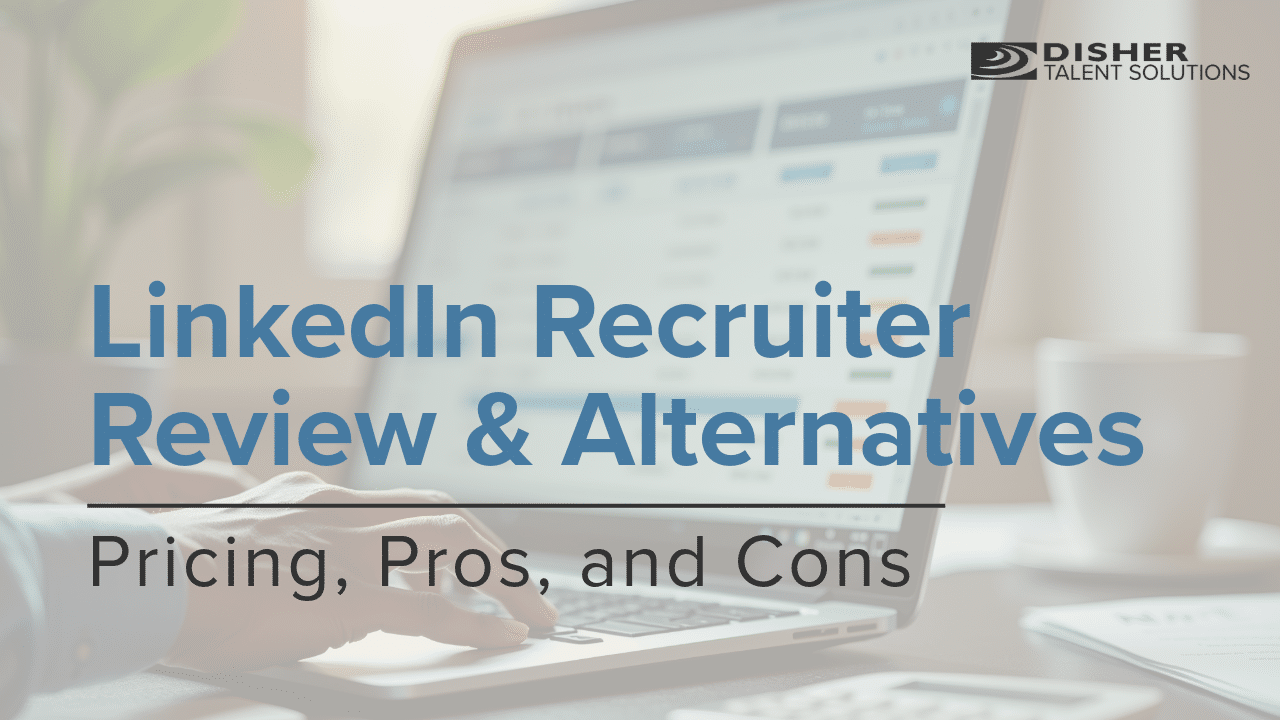LinkedIn Recruiter Review 2025: Pricing, Pros, Cons, and Top Alternatives for Hiring
September 18, 2025

LinkedIn Recruiter’s price tag isn’t small, and the pressure is on to make every dollar count. Is it genuinely worth the investment for your team’s hiring goals, or are there options that will better serve your team?
In this LinkedIn Recruiter review, you’ll get transparent, hands-on insight—what each LinkedIn Recruiter tier truly offers in 2025, what it will cost you, and how the whole package stacks up against leaner alternatives.
Here’s exactly what I’ll cover:
- What is LinkedIn Recruiter and Who Is It For?
- How Much Does LinkedIn Recruiter Cost and What Do You Get for the Price?
- How Does LinkedIn Recruiter Compare to Lite and Sales Navigator?
- Is LinkedIn Recruiter Worth It for Small Agencies vs. Enterprise Teams?
- What Are the Biggest Pros and Cons?
- What Alternatives Offer Better ROI?
- How to Decide What Tools Are Right for Your Team
What is LinkedIn Recruiter and Who Is It For?
LinkedIn Recruiter is the talent sourcing tool built for HR teams and recruiters who need access to the largest pool of professionals—over 1 billion profiles in 2025. It’s a system for discovering, tracking, and contacting candidates who aren’t actively applying to your jobs. However, it can have its limitations with specific skillsets and competition for outreach.
For large corporations, compliance-driven teams, or when everyone you want is genuinely active on the platform, it can be a strong tool. For smaller shops and agencies? You can pay premium rates for an overcrowded channel, often with unpredictable return on investment (ROI).
How Much Does LinkedIn Recruiter Cost in 2025?
Let’s cut straight to pricing—because it isn’t cheap, and hidden costs matter.
2025 U.S. Pricing Breakdown (average market rates):
| Plan Type | Monthly Cost | Annual Cost | InMail Credits | Users | Key Features |
| Recruiter Lite | $170 | ~$2,040–$2,670 | 30/mo | 1 | Basic filters, basic reporting |
| Recruiter Professional | $750 | ~$8,990 | 100/mo | 1 | Full filters, advanced analytics |
| Corporate (5+ seats) | $825/seat | ~$49,500/yr+ | 150/mo/seat | 5+ | Collaboration support |
Annual/seat pricing can vary depending on contracts, region, and volume negotiations.
The cost can be a gut-check moment for any talent organization. Note that each recruiter or sourcer needs their own seat. There’s no “floating license,” so the spend multiplies fast for larger teams.
What Do You Actually Get for the Price? Key Features Explained
LinkedIn Recruiter unlocks:
- The complete member database (not just connections or limited layers).
- 40+ search filters (including skills, titles, locations, diversity markers, and more).
- AI-powered candidate suggestions: Paste a job description, get a curated list.
- Bulk personalized InMail outreach with clearer response predictions.
- ATS integrations, candidate tracking, and reporting dashboards.
- Collaborative tools for sharing pipelines and candidate notes across your team.
LinkedIn continues to introduce AI features to automate sourcing and raise InMail response rates—so if speed and relevance are mission-critical, these matter.
LinkedIn Recruiter vs. Lite and Sales Navigator (And Why It Matters)
Many buyers wonder—Why not just use Recruiter Lite, Sales Navigator, or even a combo of tools? Here’s what changes as you move up:
| Feature | Recruiter Lite | Sales Navigator | Recruiter Professional/Corporate |
| User Type | Recruiters | Sales Teams | Recruiters (teams/orgs) |
| Database Access | Limited | Broader | Full LinkedIn database |
| Search Filters | 21 | 29 | 40+ |
| InMail Credits | 30/mo | 50/mo | 100–150/mo |
| Collaboration/ATS Integration | No | Limited | Full |
| Price (Per User, Annual) | $2,040+ | $1,200+ | $8,990+ |
Recruiter Lite is feasible for independent recruiters or small teams hiring low volume. Sales Navigator can supplement but lacks recruitment-specific filters and integrations. Big hiring projects (or compliance needs) quickly outgrow these cheaper options
Is LinkedIn Recruiter Worth It for Small Recruiting Agencies vs. Enterprise Teams?
For smaller agencies or HR teams: The Lite version can deliver value for low-volume, generalist searches. Recruiter corporate pricing will likely exceed your appetite unless hiring is your business’s lifeblood. Most SMBs are better off with Recruiter Lite or supplementary tools.
For enterprise or high-volume teams: The price stings, but the efficiency, collaboration, and advanced outreach tend to offset the cost. The real value appears as projects scale, and the time cost of manual sourcing, logging, and cross-team confusion becomes a profit drain.
Pros and Cons of Paying for LinkedIn Recruiter
Biggest advantages:
- Advanced filtering, AI-assisted matching, and outreach automation
- Centralized candidate management and real-time reporting
- Strong collaboration and compliance features for regulated industries
Biggest drawbacks:
- High per-user costs, especially for larger teams
- InMail credits run out fast with heavy recruiting; purchasing more adds up
- No sharing of seats means cost control is hard without strict monitoring
Areas to monitor:
- Each seat has a full license every year – unused licenses are still paid.
- Recruiter Lite has tight restrictions on InMail, filters, and collaboration, making it easy for anyone hiring at scale to outgrow it.
- AI, automation, and integration features are only unlocked at higher tiers.
- Geographic differences and volume contracts can swing rates from “list price”.
Alternatives That Offer Better ROI (for Some Teams)
- Alternatives to LinkedIn Recruiter are maturing—especially for budget-minded teams:
- Sales Navigator plus automation tools: Pairing Sales Navigator ($100/mo) with platforms like Linked Helper or Dripify offers outreach and filtering nearly rivaling Lite—for a fraction of the price.
- Greenhouse, Lever, or Workable: Integrated ATS + sourcing platforms can streamline your workflow and costs if you’re already using these tools for HRIS.
- AI-powered Talent Engines (Juicebox, HireEZ, SeekOut): Aggregate hundreds of millions of profiles across 30–45+ databases—GitHub, Kaggle, Dribbble, niche boards—in real time.
- ATS-integrated Sourcing & CRM: Tools like Gem, Zoho Recruit, and Findem blend candidate relationship management, messaging, and database search. CRM-centric platforms bring in multi-channel outreach, so your campaigns aren’t limited to one network.
- X-ray and Google Search Techniques: With the right search strings, you can find LinkedIn profiles—or those on GitHub, Stack Overflow, and more—without a premium LinkedIn account. Pair with a contact-finding tool for outreach and skip expensive monthly subs entirely.
For enterprise teams committed to sourcing at scale, LinkedIn Recruiter remains the most robust (and expensive) option—but the best tool is the one your team truly uses.
How to Decide What Tools Are Right for Your Team
- Map your exact hiring volume and workflow over the next year.
- Estimate the “cost-per-hire” based on your likely recruiter seat usage
- Demo alternatives, run short-term pilots, and compare not just outright spend—but the hours saved, hires made, and collaboration improvements.
- Weigh ongoing feature rollouts: Do the newest AI enhancements solve your sourcing bottlenecks, or is it more of the same?
- Decide: Are you ready to invest in scale, or do you need ROI at a lower lift this year?
The risk of overspending on LinkedIn Recruiter is real—especially if you just default to renewing. But so is the risk of missing quality hires or burning out your recruiters with inadequate tools. Transparency, current pricing data, and open internal discussion drive the best purchasing decision every time.
Reach out to our talent consultants for guidance on the best recruiting tools for your organization—and let us support your next round of hires. Our team is here to help you navigate every step with confidence.





